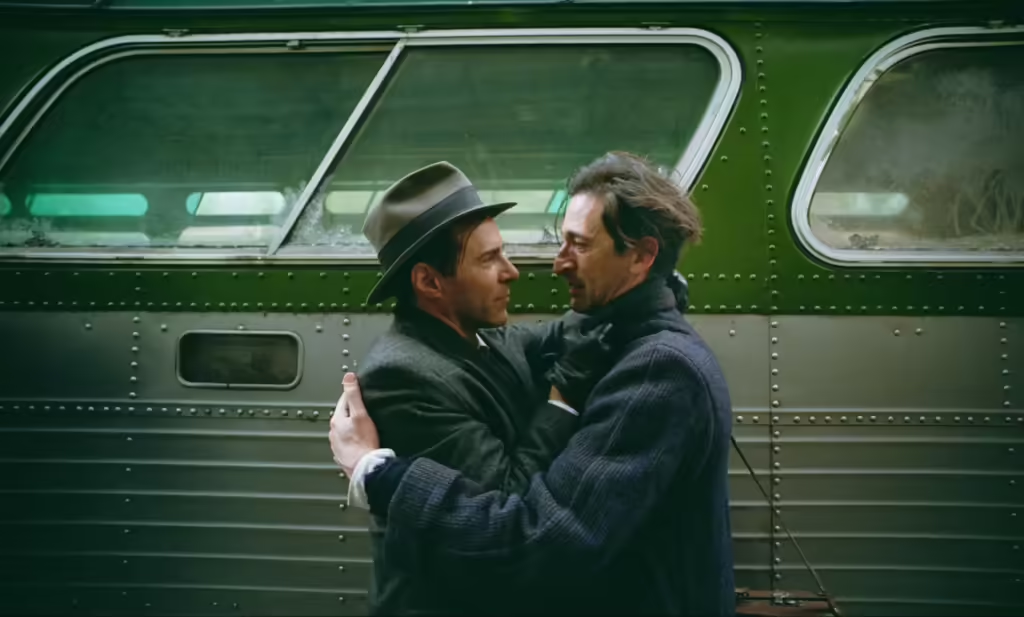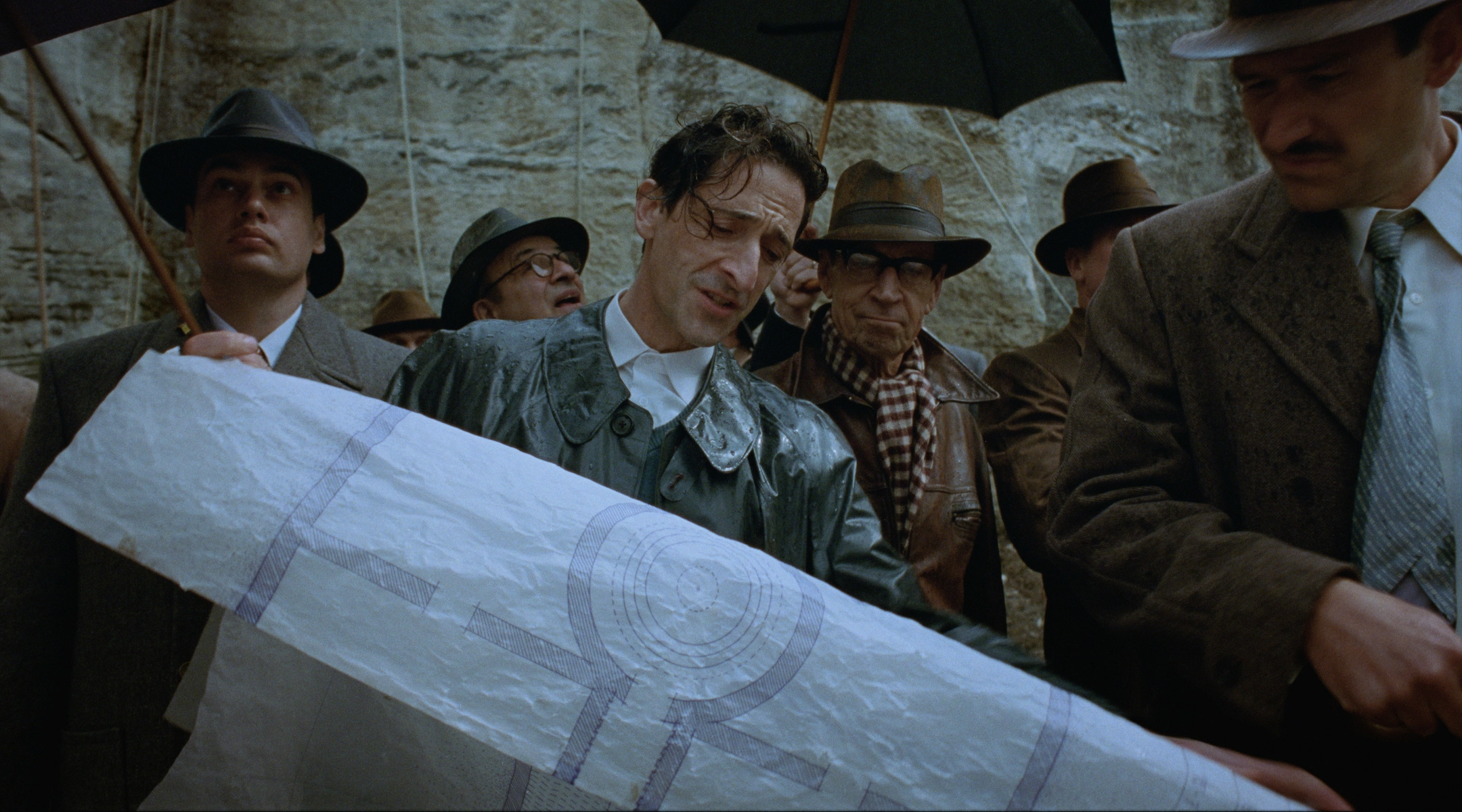Perhaps the most fascinating aspect of Brady Corbet’s remarkable The Brutalist—a sprawling, 3.5-hour immigrant epic spanning decades and continents—is its intimacy, despite its determined scale. Structured in two acts with a “built-in” fifteen-minute intermission, the film impresses in ambition and reach while maintaining an understated, almost DIY ethos that distinguishes it from the hallmarks of traditional studio epics. Purportedly made on a modest $9 million budget over several years, Corbet has crafted a massive tale that deliberately rejects the bloat—the film was shot mostly in single-takes—that often accompanies sweeping period pieces.
Instead, Corbet has made a leaner (and more affordable) treatment, sans sweep (no huge crowds, few bird’s-eye drone shots) but prioritizing character-driven storytelling over spectacle. Yet despite the scaled-down approach, The Brutalist projects the full weight and ambition of a new American classic. Corbet, the thirty-six-year-old former actor (Mysterious Skin, Funny Games) turned filmmaker (Vox Lux) sets the stage for a classic immigrant success story of ingenuity and perseverance in a foreign land; we’ve seen that one before. But almost from its “arrival in America” opening, Corbet’s vision is increasingly unsettling, shifting toward a darker contemplation of ambition, dependency and its spoils.
Adrien Brody, who won the Oscar for Roman Polanski’s The Pianist exactly two decades ago, delivers his finest performance (though my personal favorite will always be his punky outsider musician in Spike Lee’s Summer of Sam) as László Tóth, a Hungarian-Jewish architect and Holocaust survivor navigating a very daunting post-war America in 1947. Corbet and co-writer Mona Fastvold have gifted Brody an extraordinarily complex character—a tortured soul haunted by the past while driven by mad (and possibly mad by) ambition. Tóth is an intensely vulnerable, brilliant creation, giving Brody the opportunity to play dogged determination, cautious optimism and deep despair across time, all carried on his gaunt, hangdog face. He is instantly a front-of-line contender for this year’s Best Actor trophy.
When Tóth first arrives at Ellis Island, The Brutalist suggests it may be a quintessential American immigrant success story. But that opening moment, introduced by a brief overture from composer Daniel Blumberg’s muscular score, reveals one of the year’s most strikingly definitive shots: an upside-down Statue of Liberty, framed from the disoriented perspectives of European newcomers arriving aboard a steamship. This visual inversion is the film’s thesis statement on what will follow and Corbet’s first subversive indictment of the American Dream, one here bolstered by the newcomers’ collective daze toward a confusing, and hardly hopeful, new reality.

Tóth’s architectural pedigree, earned in pre-war Budapest, will not be clear until later. But in the picture’s opening act, he struggles on the rough and tumble margins of lower Manhattan, frequenting brothels and bread lines before securing work with his cousin, Atilla (a bright Alessandro Nivola), at a small furniture shop in Philadelphia. Tóth’s uneasy living arrangement with Atilla and his alluring wife (Emma Laird) will, of course, unravel, but not before a big opportunity arrives from the son (Joe Alwyn) of wealthy industrialist Harrison Lee Van Buren (Guy Pearce, superb), contracting the men to redesign his father’s library. That library’s transformation and reveal provide some of the film’s transcendent early moments; I caught my breath as the sun filled the finished room.
It’s here that Tóth’s unique talents begin to resurface. Despite his grueling, hand-to-mouth work in a local shipyard and nights in an overcrowded homeless shelter, his prospects brighten when Van Buren invites him (a terrific scene and reveal of Tóth’s pre-war genius) to conceptualize a massive project: a sprawling, multi-use property to be perched on a hill behind Van Buren’s estate. The plans include a library, athletic facilities and, most importantly, a grand chapel meant to serve the local community. But beneath this veneer of opportunity, Tóth struggles with a crippling heroin addiction. Entangled is Gordon (Isaach de Bankolé), a single, homeless father and friend Tóth hires as his right-hand foreman.
In the film’s second act, which shifts in tone and scope, Corbet introduces Tóth’s wheelchair-bound wife, Erzsébet (a fiercely independent Felicity Jones) and his war-scarred niece, Zsófia (Emma Laird). Their arrival in the U.S. brings tension, Erzsébet carving out a career writing women’s columns for a New York magazine while the marriage rifts behind the scenes (there’s a stunning sexual encounter, camera slowly drawing closer in a single spellbinding shot). At the same time, Tóth’s relentlessly unyielding perfectionism spirals into financial excess and reputational strain. Tóth is fraught with tension, not only because he is an immigrant but also a Jew, a fact that raises many a local eyebrow. And his uncompromising vision exacerbates the situation as he refuses to yield on even the smallest detail of his master plan.
This culminates in a late picture European detour, Tóth and Van Buren journeying to a remote Italian quarry in search of rare Carrara marble (Tóth scoffs at the idea of using cheaper concrete for the chapel’s inventive pulpit). It’s here that the film’s title takes on a devastating dual significance, Corbet and Fastvold pulling no punches with their social critique. While Tóth has been free to dine, socialize and gain entry to American privilege with the Van Burens’ upper class enclave, he must be taken down several pegs, reminded of class rank and how easy it is for the wealthy to pull the privileged rug from beneath. The manner in which Corbet delivers this coup de grace is more metaphor than realism, but its barbarism certainly makes his point.

The picture slips a bit in its last ten minutes; there’s a shocking public revelation (Jones’ best moment) leading to a flash-forward sequence that, to my eye, is an unsatisfying resolution for a film this good. The final sequence, a life’s work enshrinement coda with overdone aging make-up that raises timeline questions, delivers pointed notions on personal and cultural history in an artist’s work, but leaves the film’s drama frustratingly unresolved, and characters short-shrifted.
In its detail-rich craftsmanship, The Brutalist exudes artistry, every frame showcasing technical precision, every line thematically substantive and every character both human and symbolic. Corbet’s character-building feels so authentic it could easily be mistaken for a biopic of a real life 20th century architectural forerunner. And the story, with its themes of immigrant exploitation (suggested in an early scene with Zsófia and made explicit later between Van Buren and Tóth) dissects themes of class and its relationship to power, artistic demons, ennui and the incompatibility of ambition and ego.
Shot on film in the long-dormant VistaVision format, last employed in a feature film in 1961, The Brutalist leverages the expansive frame—more than double the width of standard 35mm—to underscore Corbet’s ambition, from its emotional close-ups to the creation of its architectural marvels. The film’s opening seconds, featuring the vintage VistaVision logo, are an undeniable jolt. The format, originally conceived as a rival to CinemaScope during the 1950s, harkens back to an era when cinema fought to reclaim spectacle and audiences from the encroachment of television, and was used in such classics as Vertigo and The Searchers.
But The Brutalist is a rare experience—a multifaceted exploration of the human and American condition, set against a backdrop of political and social history. It boldly grapples with the darkness of the immigrant experience and compels in its collision of idealism and pragmatism, creator and creation, ambition and classism. Corbet balances this heady order with remarkable confidence, achieving his own master plan even if his doomed protagonist endeavors at castles in the air.
A terrific movie.
3 1/2 stars



